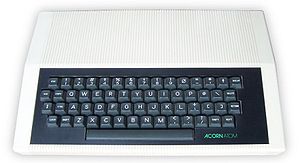Acorn Atom

The Atom was Acorn's first computer to be aimed squarely at the home market.
|
|
| Manufacturer | Acorn Computers |
|---|---|
| Type | Personal Computer |
| Release date | 1980 |
| Introductory price | £120 (in kit form), £170 (assembled) |
| Discontinued | 1983 |
| Media | 100KB 5¼-inch floppy disks, Cassette tapes |
| CPU | MOS Technology 6502 clocked at 1MHz |
| Memory | 2 KB RAM (expandable to 12 KB), 8 KB ROM (expandable to 12 KB) |
| Display | 64x64 (4 colors), 64x96 (4 colors), 128x96 (monochrome), 64x192 (4 colors), 128x192 (2 colors), 256x192 (monochrome) |
| Input | Keyboard |
| Power | 8V, 1.5A unregulated DC, 5V regulated inside. |
| Dimensions | 381×241×64 mm |
| Predecessor | Acorn System 3 |
| Successor | BBC Micro |
The Acorn Atom is a home computer made by Acorn Computers Ltd from 1980 to 1982, when it was replaced by the BBC Micro (originally Proton).
The Atom was a progression of the MOS Technology 6502-based machines that the company had been making from 1979. The Atom was a cut-down Acorn System 3 without a disk drive but with an integral keyboard and cassette tape interface, sold in either kit or complete form. In 1980 it was priced between £120 in kit form, £170 ready assembled, to over £200 for the fully expanded version with 12 KB of RAM and the floating point extension ROM.
The minimum Atom had 2 KB of RAM and 8 KB of ROM, with the maximum specification machine having 12 KB of each. An additional floating point ROM was also available. The 12 KB of RAM was divided between 1 KB for the zero page, 5 KB available for programs, and 6 KB for the high resolution graphics. The zero page was used by the CPU for stack storage, by the OS, and by the Atom BASIC for storage of the 27 variables. If high resolution graphics were not required then 5½ KB of the upper memory could be used for program storage.
It had an MC6847 Video Display Generator (VDG) video chip, allowing for both text and graphics modes. It could be connected to a TV or modified to output to a video monitor. Basic video memory was 1 KB but could be expanded to 6 KB. Since the MC6847 could only output at 60 Hz, meaning that the video could not be resolved on a large proportion of European TV sets, a 50 Hz PAL colour card was later made available. Six video modes were available, with resolutions from 64×64 in 4 colours, up to 256×192 in monochrome. At the time, 256×192 was considered to be high resolution.
...
Wikipedia
